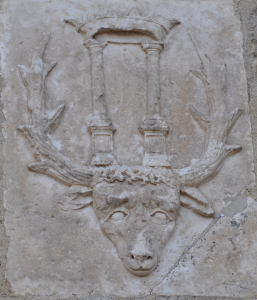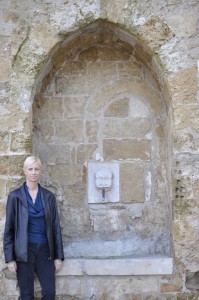While attending a party here in Italy recently, the subject of my Jewishness came up in the conversation while discussing how Hanukkah and Thanksgiving coincided this year. As the discussion progressed, I was surprised to learn that some of the Italian party-goers didn’t know how Jewish beliefs differed from Catholic ones. I tried explaining the historical development of the idea of Jesus Christ and finally a woman said, “So you don’t believe he was the Son of God!” With this summation everything became clear to the friendly but bewildered Italians. I smiled and nodded but kept my mouth shut so that I didn’t confuse them further. Ironically, the traditional Jewish term “Son of God” originally referred to the king of Israel (see p. 26, Boyarin). But that’s a different story.
This incident reminded me that several years ago when I was thinking of writing about Junia, a female disciple of Jesus, I needed to know whether the early Christians worshipped Jesus as God. As a Jewish woman, I wasn’t sure how I could write about someone who thought of Jesus as divine. In my initial research, I learned that the idea of “the Lord Jesus Christ” was a historical process, a gradual change in beliefs. Both the Hebrew Bible and the New Testament were written and rewritten over a long period of time. The editors of the texts mooshed a bunch of different ideas and time periods together, resulting in a lot of contradictions but also some amazing literature and traditions. Scholars have been able to determine what the earliest sources wrote about Jesus and perhaps even what he actually said. The research on the historical Jesus has, by and large, determined that Jesus rebuked the idea that anyone might be worshipped other than God (see Matt. 4:10/Luke 4:8). Similarly we read in Mark 10:17-18 that Jesus said, “Why do you call me good? No one is good but God alone.” It appears that Jesus did not invite anyone to worship him.
After his death, the early Christians began to worship Jesus as a way of worshipping God. By “worship” they meant reverence or devotion. To them Jesus was a reason to praise God. Regularly they gave thanks to God through Jesus. Throughout the New Testament prayer is made to God, not directly to Jesus. “In no case in the New Testament is there talk of offering cultic worship (latreuein) to Jesus.” (Dunn, p.13) Eventually Jesus began to function as an intermediary, a traditional biblical role held by angels and prophets who offered the privilege of seeing into the divine presence. Not a new idea to anyone in the time of Jesus.
So what offended Jewish sensibilities about Jesus’ followers if the early Christians didn’t elevate Jesus to the same level as God? “It was the claim that Jesus, a crucified felon, was messiah and the instrument of God’s blessing” (Dunn, p. 115). Explicit Jewish objections to claims of divinity for Jesus didn’t appear until the latest of the New Testament writings, the Gospel of John (see 5:18; 10:33), a document composed long after Jesus’ death and the destruction of the temple.
“For John clearly felt free to attribute to Jesus words and sentiments that Jesus himself probably never uttered while on earth. As most commentators realize, had the great ‘I am’ sayings been uttered by Jesus during his mission in Galilee and Judea, they would hardly have been ignored by the other Evangelists.” (Dunn, p.119)
Eventually Christian writers, such as the author of the Book of Revelation, affirmed Jesus as an unqualified deity. This was a second century development when Jews and Christians had finally parted ways.
As a Jew, I relate to the earliest, most historical accounts of Jesus where people thought there was no problem thinking of Jesus as the Messiah while at the same time keeping the laws of Moses.
“Just as today there are Jews who are Hassidic—some of whom believe that the Messiah has come, died, and will be resurrected—and Jews who reject the Hassidic movement entirely but all are considered Jews, so in antiquity there were Jews who were believers in Christ and Jews who weren’t, but all were Jews. To use another comparison that is evocative if not entirely exact, it is as if non-Christian Jews and Christian Jews were more like Catholics and Protestants today than like Jews and Christians today—parts of one religious grouping, not always living in harmony or recognizing each other’s legitimacy but still in a very important sense apprehensible as one entity.” (Boyarin, p.17)
So with this understanding of the early Christian movement, I began to write the very Jewish story of Junia.
But like I said earlier, this was my initial assessment. Recently I read, The Jewish Gospels: the Story of the Jewish Christ by Daniel Boyarin. Oh my goodness did I learn a thing or two! For example:
- Jesus and the Jews around him claimed that not only was the man from Nazareth the Messiah, but also a divine man.
- What most assume to be characteristically Christian beliefs started as Jewish beliefs, including the notion of a dual godhead with a Father and a Son, the concept of a Redeemer who would be both God and man, and the idea that this Redeemer would suffer and die as part of the salvation process.
Wowza. Boyarin walks the reader through the variety of passages in the Hebrew Bible that show the foundations of what developed into the first century concept of the Messiah. Between the Book of Daniel and the Gospels, a variety of books circulated and were considered as authoritative and influential as anything we now have in the Bible. These books developed traditions about a Davidic king and the idea of a divine-human Messiah. This figure was named “Son of Man”.
“It is no wonder, then, that when a man came who claimed and appeared in various ways to fit these characteristics, many Jews believed he was precisely the one whom they expected.” (Boyarin, p.34)
I highly recommend The Jewish Gospels for a mind-opening experience if you want to explore the making of the divine Jesus further.
Jesus can be portrayed in a variety of different ways: as a prophet, as a magician, as a miracle worker, as a rebel, as the Messiah. Before I began writing Junia, I decided to focus on his role as a healer and teacher because that is how Junia experienced him. Now that I’ve read Boyarin, I think Jesus’ role as the “Son of Man” is a more accurate assessment of how he was perceived by his contemporaries and how he viewed himself. I’m not going to rewrite my book, however. I figure the next time I write about a woman in the New Testament, I’ll take a different approach to the man from Nazareth.
I am not a messianic Jew but I do think that Jesus was an historical person surrounded by very historical and interesting women. And of course I have a weak spot for ancient, interesting biblical women.
For Further Reading
Boyarin, Daniel – The Jewish Gospels: The Story of the Jewish Christ (New York: The New Press, 2012)
Dunn, James D. G. – Did the First Christians Worship Jesus? The New Testament Evidence (Louisville, Kentucky: Westminster John Knox Press, 2010)



